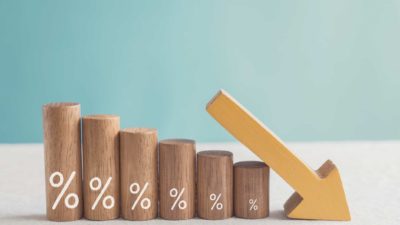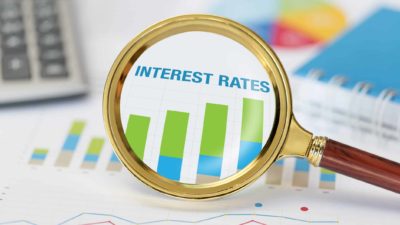If you were following the palava surrounding US President Donald Trump's tariffs over April so far, you might have heard some discussion of the bond market, and how it may have caused Trump to back down on his tariff plans.
On 2 April, or 'liberation day' as it was optimistically dubbed, Trump unveiled plans to tax almost every import coming into the United States. These tariffs ranged from a flat 10% rate that hit countries like Australia and Britain to tariffs as high as 50% for Lesotho.
As many of us would be aware, these plans seemed to be kryptonite for global share markets, with both the S&P 500 Index and the S&P/ASX 200 Index (ASX: XJO) experiencing their worst days since the outbreak of the COVID-19 pandemic in 2020.
Between 2 April and 7 April, the ASX 200 tanked by a nasty 7.5%. The S&P 500 fared even worse, falling 12.15% over the same period.
Now, you might think that this rather savage reaction from the stock market might have prompted the 90-day reprieve that Trump announced on 9 April.
However, most experts agree that it wasn't the stock market that stayed Trump's hand, but the bond market.
What is the bond market?
The bond market functions similarly to the stock market, with two notable differences. The first is obvious – it is bonds, not stocks, that are bought and sold. Bonds are essentially investments that represent loans. The most common form of a bond is a government bond. Governments all over the world issue these bonds in order to raise capital to finance government spending. Bonds usually have a fixed duration, as well as a fixed interest rate the bond will pay for that duration.
Many investors like to use government bonds in their portfolios, thanks to the income certainty and perceived safety that they offer.
The second is that the bond markets are generally not accessible to ordinary investors like the stock market is. It is usually only the biggest fish – hedge funds, institutional investors and central banks – that play there.
That's despite the bond market being far larger than the stock market in terms of the capital at play.
Why would bonds stop Trump's tariffs?
So, you might be wondering why the market for government bonds has had such a massive impact on the trade policies of a government as powerful as the United States. Well, it might not be obvious. But the bond markets hold enormous sway over what kind of economic policies a country can effectively implement. Just ask the former Prime Minister of the United Kingdom, Liz Truss. Truss's radical economic agenda was halted, along with her premiership, by the bond markets alone.
This sway that the bond markets have is due to the effects that bond pricing has on the interest rates that a government's debt can command. Government bonds are issued at a fixed yield. However, when they are traded at different prices on the bond market, this yield can change, depending on the price. This works in a similar manner to how a stock's dividend yield rises when its share price falls.
If everyone wants to buy US government bonds, also known as Treasuries, then their price will rise in the bond markets, reflecting this heightened demand. Since the interest rates those bonds pay are fixed, the yields fall when those prices do rise.
Conversely, the yields on these bonds can also rise when the prices of the bonds are falling.
And that's what got Trump's tariffs in trouble.
A self-inflicted interest rate rise
Although Trump had promised that his new 'reciprocal tariffs' would usher in a new economic golden age for America, investors were skeptical. After all, tariffs are shunned by almost every mainstream economist as damaging and distortionary taxes that weaken economic growth whilst increasing inflationary pressures.
Taking the level of tariffs that the United States levies on other countries back to levels not seen since the 1930s spooked more than a few investors. As a result, they began selling government bonds when these tariffs were announced. As we discussed earlier, this had the effect of increasing the interest rates that these bonds pay on the bond market.
According to CNBC, the yield on a 10-year Treasury bond rose from around 4% just before liberation day on 2 April to almost 4.5% by 11 April. Now, an increase of half a percent might not sound like a big deal. But just think about what a 50 basis point rise would mean to a mortgage holder, for example. Then, consider that the US government has a total debt level exceeding US$36.2 trillion.
It certainly is a big deal.
The US government doesn't want to pay interest on its debt at anything except the lowest possible interest rate. The exodus out of US government bonds following the tariff announcements indicated a loss of faith in the US government's economic future and, by extension, a possible loss of faith in the US dollar as the world's reserve currency. That is unacceptable to any US president. As such, the tariffs had to go. Or, at least be deferred.
What does the bond market have to do with ASX shares?
Apart from influencing US government policy, the bond markets have huge implications for the share market. For one, they seem to have played a 'vigilante' role, protecting the global economy from what bond investors clearly deemed to be bad policy.
But the movements of the bond market flow into shares in other ways. You may have heard some discussion about how interest rate moves from our own Reserve Bank of Australia (RBA) affect our own stock market.
The interest rates on bonds are effectively a price on a 'safe' asset – cash. Borrowing money from any government is usually deemed a 'risk-free' investment as governments of advanced economies rarely 'go broke'. They can always print more money if they are in danger of defaulting, after all.
However, companies can and do go broke. That means their shares are not risk-free.
When the yield on cash and government bonds are high, it can pull money out of the share market as many investors opt for more attractive, safe investments. The opposite is also true when rates fall.
Normally, the only time this matters to investors is when central banks change their interest rates. But an event like the tariffs effectively functioned as its own interest rate hike.
This is how the bond markets can have an impact on what happens in the share market. So keep an eye on bonds for the rest of 2025 and beyond. We might not have seen the last demonstration of their power.









